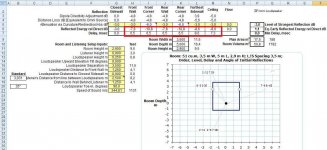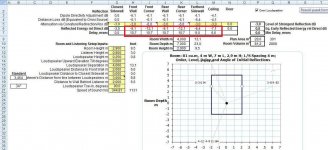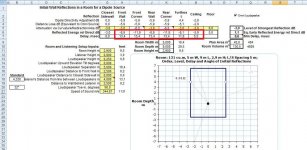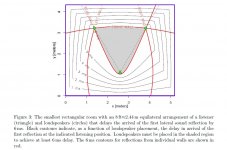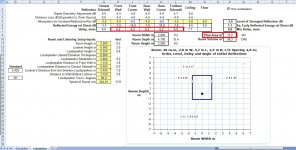Japanese flooder
1960's
Toshiba SS-64
more details here: Toshiba/Aurex ƒXƒs�[ƒJ�[ƒVƒXƒeƒ€SS-64‚ÌŽd—l “ŒŽÅ/ƒI�[ƒŒƒbƒNƒX - but I am not sure whether those were designed for the floor coupled position
anothe one of the kind: http://audio-heritage.jp/AUREX/speaker/ss-61.html
OTOH another piramidal and this time indeed a floor coupled speaker though not that up-firing - Tetra 306:

Note: Thread title changed.
...
And all this in a relatively small listening room. The bigger the better.
and below is shown how it looks - in a small, medium and big room respectively - according to the spreadsheet from Linkwitzlab website, exactly as predicted and quite as good as it gets as well I would say
Attachments
OTOH another piramidal and this time indeed a floor coupled speaker though not that up-firing - Tetra 306:

interesting, reportedly no sound-coming-from-the-floor experience with Tetras:
it had no trouble floating the image of a concert grand piano at the proper height and width
see: Welcome to www.SoundStageAV.com
I can think of two reasons why the 22" tall Tetras sound image did not come from the floor:interesting, reportedly no sound-coming-from-the-floor experience with Tetras:
1) The Tetra's tweeter is about 15" off the floor and is directly pointed at the listening position.
2) Jim Saxon's head position may not have fully recovered after this review:
"For excellence in engineering as well as champion sound, Aurum Acoustics, of Newfoundland, Canada, wins two gold statuettes. When I heard the filigreed plaints of Aaron Neville, my head rolled around and fell on the floor."
He also wrote:
"the Kings placed the solo piano about 3’ behind the plane of the speakers."
I am inclined to question the location ability of someone who's head is not screwed on tight
Art
2) Jim Saxon's head position may not have fully recovered after this review:
"..., my head rolled around and fell on the floor."
I am inclined to question the location ability of someone who's head is not screwed on tight.
Art
LMMFAO!
I can think of two reasons why the 22" tall Tetras sound image did not come from the floor:
1) The Tetra's tweeter is about 15" off the floor and is directly pointed at the listening position.
still 15'' is not a proper height for a concert grand piano, is it?
still 15'' is not a proper height for a concert grand piano, is it?
That's because it's in the pit!
Schroeder agrees with Jim that it is.still 15'' is not a proper height for a concert grand piano, is it?
Attachments
better play with the spreadsheet linked above, instead of the toy piano 
let us see what it takes to place a conventional stereo triangle of similar proportions, with speaker moved into the room away from the side walls, in a room of similar size, and how the pattern of early reflections looks then
let us see what it takes to place a conventional stereo triangle of similar proportions, with speaker moved into the room away from the side walls, in a room of similar size, and how the pattern of early reflections looks then
Last edited:
Use a measurement microphone, some real speakers playing in a room, and look at the resulting spectrogram, and see the real reflections.
You mean that real reflections follow some other kind of physics?
That's what I experienced when rotating my dipoles 90°. I calculated the early reflections with James Heddles spreadsheet at http://www.linkwitzlab.com/LX521/Dipole First Room Reflections SL rev3-a.xls
View attachment 357016 View attachment 357017
Left picture is what I have at home - and like. Right is the Stereo Unlimited proposal
.
Rudolf - please explain
Last edited:
You mean that real reflections follow some other kind of physics?
Rudolf - please explain
Yes, the real physics of real radiators in real baffles, with all the real minutia of the real room.
Yeah, great spreadsheet. A visualization tool as an aide to understanding complexity and compromise in asymmetrical speaker placement.
Real measurements make for reality check, something you are long overdue for.
Rudolf has got real speakers, does real placements, and often makes (and shares) real measurements that support his personal perceptions.
Your thread continues to be a fantasy farce devoid of substance.
Yes, the real physics of real radiators in real baffles, with all the real minutia of the real room.
so You believe in some minutia that can change the time of delays?
Is that what You say?
see also: the required room dimensions and speaker setups to obtain a >6 ms delay for the first order reflections by Richard Taylor
below is shown "the smallest rectangular room for 6 ms delays" according to Mr Taylor
thanks to Mr Beveridge and His pioneering work and to Mr Heddle and His useful spreadsheet we know that Mr Taylor is wrong, because the 6 ms threshold can be achieved in an even smaller room with on-wall speakers and the side-wall ("Beveridge") placement method
below is shown "the smallest rectangular room for 6 ms delays" according to Mr Taylor
thanks to Mr Beveridge and His pioneering work and to Mr Heddle and His useful spreadsheet we know that Mr Taylor is wrong, because the 6 ms threshold can be achieved in an even smaller room with on-wall speakers and the side-wall ("Beveridge") placement method
Attachments
Mr Taylor's the smallest room usable for stereo reproduction is around 21.8 m2
whereas in fact the smallest room can be as small as 13.2 m2 (see below) HUGE - 40% - difference

whereas in fact the smallest room can be as small as 13.2 m2 (see below) HUGE - 40% - difference
Attachments
If early reflections in the room are only 6-10 dB down and only 6-10 ms late, they mask some information in the original recording and introduce new unwanted localization hints, thereby smearing the original localisation information.
This doesn't need to be certified by theory - it jumps at you when listening to it. And it doesn't become wrong, because some individuals don't care about it.
I have early reflections down at least -15 dB for the first 15 ms with just a few room correction measures, and this helps significantly already. -20 dB for the first 20 ms would be even better.
This doesn't need to be certified by theory - it jumps at you when listening to it. And it doesn't become wrong, because some individuals don't care about it.
I have early reflections down at least -15 dB for the first 15 ms with just a few room correction measures, and this helps significantly already. -20 dB for the first 20 ms would be even better.
If early reflections in the room are only 6-10 dB down and only 6-10 ms late, they mask some information
..."some" ...perhaps
I have early reflections down at least -15 dB for the first 15 ms
including the floor and ceiling reflections?
Besides, on the spreadsheet diagram that You posted I can see that @~8 ms there is one reflection -15 dB and two -21 dB. As these are calculated on some assumptions and as You do the measurements - is this confirmed by measurements?
-20 dB for the first 20 ms would be even better.
...You expect according to a theory or You just believe that it would just jump at You?
Last edited:
..."some" ...perhaps
however I am with Dr Geddes:
In all cases, lower levels of reflections are better in the first 10 ms. After about 10 ms I would claim that all lateral reflections are good
the problem is that He Himself in His rather big 16x25 ft HT room:
can't get 10 ms of reflection free signal.
- Home
- Loudspeakers
- Multi-Way
- The Advantages of Floor Coupled Up-Firing Speakers
